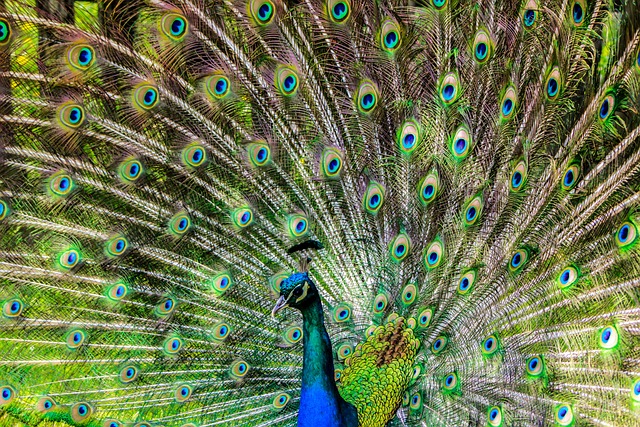Have you ever seen a peacock spread its vibrant feathers in a display of beauty and wondered, can these magnificent creatures actually fly?
Despite their seemingly cumbersome and heavy plumage, the answer may surprise you.
For centuries, the flying abilities of peacocks have been the subject of much debate and speculation.
In this article, we will explore the facts and fiction surrounding the flight of peacocks and uncover the truth about these stunning birds.
So, buckle up and join us on a journey to discover that Can Peacocks Fly?

Can Peacocks Fly?
Yes, peacocks can fly, but their flight is limited to short distances and is usually used to escape predators or reach roosting spots in trees.
Their large, showy tail feathers, or “train,” can make it more difficult for them to fly long distances.
Although they have the ability to fly, peacocks don’t use it like most other birds.
Only 2% of a peacock’s life will be spent in the air, and they aren’t exactly elegant fliers when they do.
Similar to other avian species that lack the ability to fly, these birds have a heightened awareness of their surroundings that correlates with the presence or absence of favorable conditions for flight.
Not migrating or swooping down on prey with their wings is how these birds differ from most others in the flying avian kingdom.
They still rely mostly on their feet for mobility, but flying has evolved into a secondary way of navigation.
With their talons, they can run at speeds of up to 15 miles an hour, and their claws may be used as a lethal weapon in the face of potential threats.
For such skilled foragers, this evolutionary change makes perfect sense.
They have similar behaviors with turkeys, pheasants, and chickens due to their close genetic relationship to these birds.
Peacocks are omnivores that forage and hunt on the ground for food, which includes anything from insects, berries, and seeds to reptiles and small animals.
Even though their trailing plumage draws the attention of potential predators, it may be ripped off without harming the bird.
Flying is more of a protection mechanism than a method of regular transportation.
In order to reach their roosting height, peacocks will utilize their wings to push themselves vertically upward.
These birds will fly high into the treetops to hide from any threats and roost for the night without fear of being harmed.
Peacocks are equipped with a variety of powerful defensive measures. When threatened, a peacock would spread its tail feathers like a fan.
This makes them seem much larger than they really are, which might scare off a raccoon or tiger.
A pair of sharp spurs on each foot serves as their primary weapon of defense against predators.
Predators that go too near will be sliced up by the “kicking thorns” on this plant.
Therefore, even when threatened by predators, peacocks can avoid excessive wing use.
How Far and How High Can Peacock’s Really Fly?

Peacocks are capable of flying short distances, typically up to about 200 meters (656 feet), and reaching heights of up to 10 meters (33 feet) above the ground.
However, they are not strong or sustained fliers and their flight is more of a gliding or hopping motion.
Unfortunately, peacocks can’t fly in the air for long because of their heavy build and design.
Peacocks can increase their range by propelling themselves off taller branches, but even the most impressive of them still have trouble flying more than 350+ feet.
This is far longer than a chicken and on par with a turkey.
Conclusion
In conclusion, while peacocks are known for their stunning display of feathers, they are also capable of flight, though only for short distances and at relatively low altitudes.
Their flight is primarily used for survival and getting to roosting spots, rather than for long-distance travel.
Nevertheless, the ability of peacocks to fly adds to the impressive list of features that make them one of the most fascinating and beautiful birds in the world.
FAQ
Can all peacocks fly?
Yes, both male peacocks (peafowl) and female peacocks (peahens) are capable of flying.
How long can peacocks fly for?
Peacocks are not strong or sustained fliers, so they can only fly short distances for up to about 200 meters.
What is the purpose of a peacock's tail feathers?
The primary purpose of a peacock’s tail feathers, or “train,” is for mating and attracting mates. The train is used in elaborate courtship displays to attract females.
Do peacocks use their wings for anything other than flying?
Yes, peacocks also use their wings for other functions, such as for balance when walking or running, and for displaying aggression or dominance.
How high can peacocks fly?
Peacocks can fly up to about 10 meters (33 feet) above the ground.
How fast can peacocks fly?
Peacocks typically fly at speeds of up to about 16-24 km/h (10-15 mph).
Why do peacocks fly?
Peacocks primarily use their flight to escape danger or predators and to reach roosting spots in trees at night.
Are peacocks good fliers?
No, peacocks are not strong or sustained fliers, and their flight is more of a gliding or hopping motion.
How do peacocks compare to other birds in terms of flight ability?
Compared to other birds, peacocks are not strong or sustained fliers, and their flight ability is relatively limited. They are much better known for their beautiful feathers and elaborate courtship displays.
Last Updated on March 22, 2023 by Lily Aldrin
